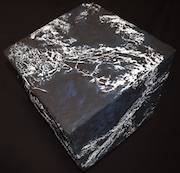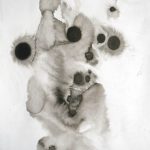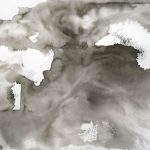With Robert Rich by Pedro Santos for a Portuguese music magazine, in late1995.
– Yearning is a beautiful CD. It’s nice to hear you making slow music again.
I am very glad that you like Yearning. It is an album that I have
always wanted to make. Actually, I have never stopped making long,
slow music. It’s just that I have many interests and musical
directions, and I like to explore them all. I enjoy making rhythmic,
melodic and noisy music too. It is true, however, that the work to
remix Trances and Drones put me back into a state of mind for very
slow music.
– What pushed you (or Lisa) to work together?
I heard a tape she did, and I liked her playing. I invited her to
play on a song for Propagation (“Whispers of Eden”) and we got along
well together. I discussed my idea for Yearning with her, and she was
interested in doing it with me.
-How did you work together? How was your recording methods?
Lisa came to my studio three times, and I recorded about 6
hours of her improvising, with modes and tunings that we worked out
in advance. I chose my favorite sections from these tapes and spent
the next two months editing her performances into the form you hear,
then spent another 3 months working on my own parts, mixing, etc.
-Did you have before any relation with indian
music? Do you think you had to have an indian
musical knowledge to construct yearning with
Lisa?
I have been listening to Indian music for about 15 years. It is one of
my favorite musical cultures. I think a knowledge of Indian modes
and tunings was necessary to bring my voice to this music. I spent
many weeks evaluating the microtonal expressions in Lisa’s playing
and comparing them to other players, and I made several flutes using
these tunings in order to record parts that fit into her playing.
However, I do not think of this as an “Indian” album. Both Lisa and I
are American, and I think we bring our own way of thinking to this
music.
-Why did you approach Alap?
How do you describe emotionally Alap?
Alap is my favorite form in Indian music. It is the most
introspective, the deepest part of the raga. Alap can describe many
different emotions, depending on the raga and the state of the
performer. I think the title of this album pretty much describes the
emotion I was seeking.
-Is it all improvisation? Is Lisa
improvising or just basing her play in
known indian music plays?
Raga is a combination of improvisation and composition. The two are
closely intertwined. To perform a raga well requires years of
practice. However, it can be slightly different each time you play it.
Once I edited lisa’s parts, I carefully composed my own layers of
sound, but some of my own playing is also based on improvisation at
some level.
-Is there something new in your electronic
tapestry that I don’t know? Any kind of
electronic harmonic series?
My electronic equipment changes slowly, but I don’t use anything very
unusual. My biggest direction has been towards fusing electronic and
acoustic sounds, so the two are indistinguishable. Most of the sounds
on Yearning are acoustic in origin, then radically processed via
electronics. My music is still based on micotonal tuning systems,
primarily just intonation, which, as you suggest, uses the harmonic
series as its basis.
-Do you feel nearer to your early ambient phase (you
remixed Trances and Drones, didn’t you?), or closer to
Rainforest or Gaudi? That is to say, what do you really
feel when you look now to your work?
As I mentioned earlier. I have many interests, and I do what I feel
will be new and exciting to me. I try to make albums that I would like
to listen to. In some ways, I do feel very close to my early, slow
work, but I don’t feel that I want to keep doing the same thing
forever. I like to explore. For example, my next album will be very
deep, slow and experimental – it is a collaboration with Lustmord
called “Stalker”. However, my next solo album will be very rhythmic
and heavy, a bit closer to Propagation in feel.
– What was the purpose of sleep concerts?
Is it ok if people fall asleep?
Words on Trances/Drones?
When I played the sleep concerts, I encouraged people to fall asleep.
The concerts lasted all night, from 11:00 PM to 8:00 AM. I wanted the
listeners to discover the region between sleep and waking, the hypnogogic
state, where thinking is visual and non-linear, where the slow textures of
my music would merge with dreams and create an altered state of
consciousness. I wanted to undermine people’s listening expectations,
so they would be open to very slow changes, so they would become more
sensitive to the power of their sonic environment. I wanted to transform
the typical concert experience into a trance ritual.
Trances and Drones were my second and third cassette releases, from 1984
(the first was Sunyata, in 1982). These early recordings were attempts to
translate the experience of a sleep concert to a recording, although even at
that time I doubted it was possible. Because of the shorter duration, I chose to
make the music more active, but it was still very slow. The 2 CD re-release on
Extreme contains re-mixed versions of all of Trances and Drones along with the
title track to Sunyata, which is the only track I could salvage from those early
tapes. There is also a previously unreleased drone from the same period,
“Resonance”, which probably shows best what a portion of a sleep concert
actually sounded like.
-Do you think your work with Lisa isn’t
extendable to the other parts of the raga?
How do you think the audience will receive
Yearning? How do you want them to react?
I hope that people will take the time to experience this music
slowly, rather than make quick judgements after a few minutes. This
is music that is meant to create a deep space over time, and over
many repeated listens. I do not think Yearning is an album for
everyone. It takes some understanding and patience. It can be a
challenge sometimes for people to understand music from other
cultures. In the West we often use “non-Western” sounds for their
novelty value. I am not interested in that approach. I respond to
music whenever it reaches something universal inside of me,
whenever it pulls at me from deep down, and I don’t think this
response is bound to a particular culture. I hope that people respond
to Yearning in a similar way. I simply find that certain non-Western
musical forms (including Indian music) have mastered the
“technologies” of trance better than we have in the West, and I think
we can learn from these styles when we approach them with respect.






You must be logged in to post a comment.